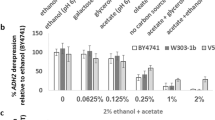Abstract.
Glucose and other sugars, such as galactose or maltose, are able to cause carbon catabolite repression in Saccharomyces cerevisiae. Although glycolytic intermediates have been suggested as signal for repression, no evidence for such a control mechanism is available. The establishment of a correlation between levels of intracellular metabolites and the extent of catabolite repression may facilitate the identification of potential signal molecules in the process. To set a framework for such a study, the repression produced by xylose, glycerol and dihydroxyacetone upon genes belonging to different repressible circuits was tested, using an engineered strain of S. cerevisiae able to metabolize xylose. Xylose decreased the derepression of various enzymes in the presence of ethanol by at least 10-fold; the corresponding mRNAs were not detected in these conditions. Xylose also impaired the derepression of galactokinase and invertase. Glycerol and dihydroxyacetone decreased 2- to 3-fold the derepression observed in ethanol or galactose but did not affect invertase derepression. For yeast cells grown in media with different carbon sources, no correlation was found between repression of fructose-1,6-bisphosphatase and intracellular levels of glucose 6-phosphate or fructose 1,6-bisphosphate.

Similar content being viewed by others
References
Bergmeyer H (1983) Methods of enzymatic analysis. Verlag Chemie, Weinheim
Blázquez MA, Lagunas R, Gancedo C, Gancedo JM (1993) Trehalose-6-phosphate, a new regulator of yeast glycolysis that inhibits hexokinases. FEBS Lett 329:51–54
Carlson M (1999) Glucose repression in yeast. Curr Opin Microbiol 2:202–207
Chomczynscki P, Sacchi N (1987) Single-step method of RNA isolation by acid guanidium thiocyanate-phenol-chloroform extraction. Anal Biochem 162:156–159
Dixon GH, Kornberg HL (1959) Assay methods for key enzymes of the glyoxylate cycle. Biochem J 72:3P
Doherty D (1970) l-Glutamate dehydrogenases (yeast). Methods Enzymol 17A:850–856
Eberts TJ, Sample RH, Glick MR, Ellis GH (1979) A simplified, colorimetric micromethod for xylose in serum or urine, with phloroglucinol. Clin Chem 25:1440–1443
Eliasson A, Christensson C, Wahlbom CF, Hahn-Hagerdal B (2000) Anaerobic xylose fermentation by recombinant Saccharomyces cerevisiae carrying XYL1, XYL2, and XKS1 in mineral medium chemostat cultures. Appl Environ Microbiol 66:3381–3386
Fernández E, Fernández M, Moreno F, Rodicio R (1993) Transcriptional regulation of the isocitrate lyase encoding gene in Saccharomyces cerevisiae. FEBS Lett 333:238–242
Gamo FJ, Lafuente MJ, Gancedo C (1994) The mutation DGT1-1 decreases glucose transport and alleviates carbon catabolite repression in Saccharomyces cerevisiae. J Bacteriol 176:7423–7429
Gancedo JM (1998) Yeast carbon catabolite repression. Microbiol Mol Biol Rev 62:334–361
Gancedo JM, Gancedo C (1971) Fructose-1,6-diphosphatase, phosphofructokinase and glucose-6-phosphate dehydrogenase in fermenting and non-fermenting yeasts. Arch Microbiol 76:132–138
Gancedo JM, Gancedo C (1973) Concentration of intermediary metabolites in yeast. Biochimie 55:205–211
Goldstein A, Lampen JO (1975) β-d-Fructofuranoside fructohydrolase from yeast. Methods Enzymol 42:504–511
Johnston M (1999) Feasting, fasting and fermenting. Glucose sensing in yeast and other cells. Trends Genet 15:29–33
Maitra PK, Lobo Z (1971) A kinetic study of glycolytic enzyme synthesis in yeast. J Biol Chem 246:475–488
Polakis E, Bartley W (1965) Changes in the enzyme activities of Saccharomyces cerevisiae during aerobic growth on different carbon sources. Biochem J 97:284–297
Rodríguez C, Gancedo JM (1999) Glucose signaling in yeast is partially mimicked by galactose and does not require the Tps1 protein. Mol Cell Biol Res Commun 1: 52–58
Sáez MJ, Lagunas R (1976) Determination of intermediary metabolites in yeast. Critical examination of the effect of sampling conditions and recommendations for obtaining true levels. Mol Cell Biochem 13:73–78
Schöler A, Schüller H-J (1993) Structure and regulation of the isocitrate lyase gene ICL1 from the yeast Saccharomyces cerevisiae. Curr Genet 23:375–381
Schüller HJ (2003) Transcriptional control of nonfermentative metabolism in the yeast Saccharomyces cerevisiae. Curr Genet 43:139–160
Van Aelst L, Hohmann S, Bulaya B, Koning W de, Sierkstra L, Neves MJ, Luyten K, Alijo R, Ramos J, Cocceti P, Martegani E, Magalhaes-Rocha NM de, Brandao RL, Van Dijk P, Vanhalewyn M, Durnez P, Jans AWH, Thevelein JM (1993) Molecular cloning of a gene involved in glucose sensing in the yeast Saccharomyces cerevisiae. Mol Microbiol 8:927–943
Vincent O, Townley R, Kuchin S, Carlson M (2001) Subcellular localization of the Snf1 kinase is regulated by specific beta subunits and a novel glucose signaling mechanism. Genes Dev 15:1104–1114
Zaragoza O, Gancedo JM (2001) Elements from the cAMP signaling pathway are involved in the control of expression of the yeast gluconeogenic gene FBP1. FEBS Lett 506:262–266
Zaragoza O, Lindley C, Gancedo JM (1999) Cyclic AMP can decrease expression of genes subject to catabolite repression in Saccharomyces cerevisiae. J Bacteriol 181:2640–2642
Zaragoza O, Vincent O, Gancedo JM (2001) Regulatory elements in the FBP1 promoter respond differently to glucose-dependent signals in Saccharomyces cerevisiae. Biochem J 359:193–201
Acknowledgements.
We thank B. Hahn-Hägerdal and P. Kötter for providing yeast strains. We are indebted to Eduardo Silles for determining the concentration of intracellular metabolites. This work was supported by EU project BIO-HUG QLK3-CT-1999-00080 and by grant BMC2001-1690-CO2-01 from the Dirección General de Investigación Científica y Técnica. M.M. had a fellowship from the EU and later from the DGICYT.
Author information
Authors and Affiliations
Corresponding author
Rights and permissions
About this article
Cite this article
Belinchón, M.M., Gancedo, J.M. Xylose and some non-sugar carbon sources cause catabolite repression in Saccharomyces cerevisiae . Arch Microbiol 180, 293–297 (2003). https://doi.org/10.1007/s00203-003-0593-9
Received:
Revised:
Accepted:
Published:
Issue Date:
DOI: https://doi.org/10.1007/s00203-003-0593-9




